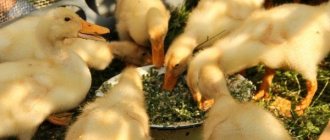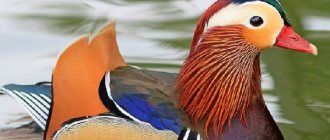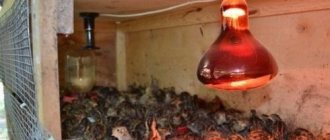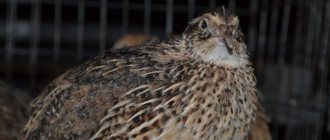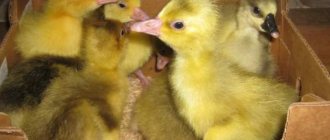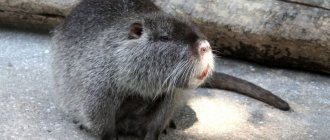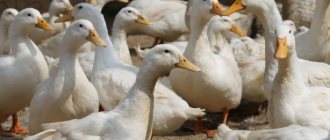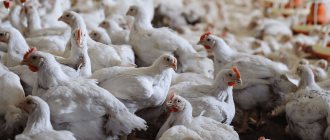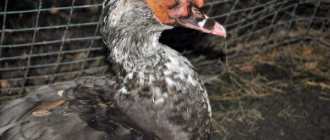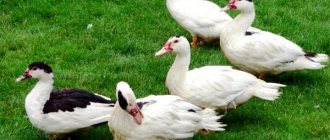Is it possible to raise wild ducks at home?
Differences between wild animals and domesticated breeds.
Wild mallard ducks
- The meat of a wild animal is slightly bitter, but there is a slight hint of sweetness.
- In appearance, wild and domesticated breeds differ little. However, poultry has wider shapes and different colors.
- The shells of wild eggs are green, while those of domesticated eggs are white. Sometimes a slightly greenish tint appears on it, and there is a greasy sheen.
- Breeding wild ducks, keeping. Wild animals are less whimsical. An incubator is not required for breeding. They feel good in any weather.
Let's sum it up
Wild ducks today are increasingly found on domestic farms. The thing is that, despite the lower characteristics of the final product produced by the duck compared to long-domesticated species of this bird, its unpretentiousness leads to much lower rearing costs, while providing decent quantitative and qualitative characteristics:
- duck meat;
- feather and down;
- fat;
- eggs.
Keeping wild ducks is a profitable business for modern farmers
By taming wild ducks, you can also reduce the initial cost of purchasing ducks for breeding. As a result, you will only need to provide the bird with decent living conditions. If you successfully cope with breeding mallards, then you can then move on to more demanding and whimsical fruits of breeding work.
Independent breeding of such birds requires preliminary preparation of a room for keeping them. However, even beginners in the field of poultry farming without any experience can cope with this process.
Features of breeding and keeping wild ducks
No specific conditions needed. Animals are unpretentious when it comes to food: they do not need special food. There is no need to equip the cages additionally; heating the poultry house is not required. This is due to the fact that wild animals are less whimsical.
There is no need to purchase an incubator, which will please beginners. At any time of the year, individuals live quietly in a brick building. In order for the birds to feel good, it is necessary to make a pen with a net. Animals can easily tolerate low temperatures; even in frosty conditions, wild animals feel great.
How to tame a wild duck
In summer, birds are provided with a place to swim. This could be a pond or small body of water. For ducks, summer is swimming season. There should also be water in the drinking bowl. This rule applies to all months. The water container should always be full. Only clean, fresh water is suitable.
Wild individuals catch small fish from reservoirs. It is recommended to add it to the diet of animals. If it rains or gets hot outside, the birds hide in shelter. It is necessary to build a canopy for this. There you can hide from the rain and hot sun.
Walking the ducks
As for the fenced area near the poultry house, where the ducks can walk, it is also made small. This is a kind of cage pen made of metal mesh. It's easy to do. Logs are driven in around the perimeter, onto which the mesh is nailed. The height of the structure should be about 2 meters.
It is very good if there is a duck pond next to the bird house. These birds love to swim, and for them a lesson on a pond will be a positive moment of the day. Little ducklings should also walk separately.
It is customary for ducks to be released for a walk after 10 am. Since until this time, females lay eggs. They should be driven back in the late afternoon. It is best if the ducks can get into the house directly from the pen. Thanks to this, they will be able to hide from bad weather. The outdoor pen should have drinking bowls and feeders, into which the owner, if desired, places fresh cut grass.
What types of wild animals can be kept at home?
Mallards - ducks that can be domesticated
- Mallard. In Russia, the Mallard is the largest bird. Depending on the sex, months can weigh up to 2 kg. The wings are large and strong. The span reaches 1 m. Females and males have different shades of color. Females have brownish plumage. This color helps them camouflage and hide from danger in the forest.
The male is different in color. Its plumage on the head and neck is dark green, the lower body is grayish in color. The beak and paws have a bright red tint. The offspring of this breed have a light brownish color. This type of duck requires a pond. They love small, shallow lakes.
Dear visitors, save this article on social networks. We publish very useful articles that will help you in your business. Share! Click!
- Red-headed Pochard. The dimensions are average, weight - up to 1.2 kg. The head is painted a bright red shade, hence the name of the breed. Birds arrive in the spring, when there is no longer snow or ice. These birds live in a flock. Males and females differ little in weight and size. The former are 300 g larger than the latter. Representatives of the breed love small ponds with thickets of grass and reeds.
In dense vegetation, birds make nests and raise their young. This should be taken into account when arranging a habitat for an individual at home. The eggs have a greenish tint.
- Gray ducks. Similar to a mallard, but much lighter in weight. Females and males are similar in appearance and have no differences. Bird weight is up to 1.5 kg. The plumage is light brown, with small white spots on the wings.
The plumage of the drake is gray. They shed heavily during the breeding season and become the same color as the female. Birds moult a lot in the summer, so they cannot fly at these times. They hide in thickets and bushes.
What should you keep in mind?
Keeping and growing are not easy tasks. First you need to decide on the breed.
If you feed her correctly and systematically, monitor the conditions, and ensure good maintenance, she will be able to produce 4 times more eggs and gain weight faster.
Next you need to decide on the site. When creating a farm, this is one of the important points that is not always paid attention to. The site should not be too far from the release site in hunting conditions. In this case, the place should not be closer than 1 km to a populated area.
It is imperative to arrange a pond on the farm territory. The drakes are kept in separate pens. The breeding stock is also housed separately. It is recommended to locate the site away from the city. The sizes depend on the livestock that is planned.
The chicks are hatched naturally without an incubator. After hatching, the young animals are released into common areas. Now he can be walked with the rest of the livestock.
Since wild ducks are waterfowl, they react negatively to temperature changes. Therefore, it is worth taking care of the building where the poultry house will be located - there should be no cracks or holes. They make a walk next to the poultry house. There should be enough space for movement in the fresh air to make the contents comfortable.
Walking wild ducks
You can limit the walking space with a mesh fence. The height of the fence is 1.5 m. If you plan to keep large numbers of individuals, do not put water in the walking area. Otherwise, the site will be dirty and untidy, and the “residents” will start fighting.
In the poultry house, you need to select and arrange three places: for ducklings, broodstock, and grown-up individuals. The broodstock includes two families of 3-4 laying hens and one drake. Such a flock will allow you to get enough eggs. The poultry house must have not only feeders, but also drinkers, otherwise the animals will look for water for themselves. Containers for water and food are also installed on the paddock.
It is better not to install open drinkers in the poultry house. This is inconvenient, especially in winter, since ducks can swim in drinking bowls in the cold and freeze.
Read also: How to keep Star-53 ducks at home
Open drinking bowls must be removed. Nests must be placed in the areas where the broodstock are located.
Winter foster care
The diet in the winter months is different due to the lack of green food. To provide the birds with proper nutrition, potatoes, carrots, cabbage, beets, hay and mineral supplements are harvested in the summer. Over the winter, an adult eats up to 13 kg of potatoes, 12 kg of vegetables, 8 kg of hay and 1 kg of mineral supplements. Due to the lack of grass, feeding is carried out three times a day. They give wet mash for breakfast and lunch, and dry food for dinner. Mineral supplements and drinking water are freely available around the clock. It is better to prepare mash mixtures using warm meat broths. If ducks do not eat well, mineral and vitamin complexes are included in the diet. The first feeding is carried out no later than 8 am, the last - at 5-6 pm.
Birds are not afraid of the cold, which is why there is no need to take special care of them. After breakfast they are released into the fresh air. In the poultry house, the entrance for the birds is left open so that they can, if necessary, drink or eat, or hide from the frost.
Day old ducklings - care and maintenance. Problem with the duckling waterer.
Caring for ducklings.
Feeding ducklings
How to feed?
Not only maintenance, but also proper feeding is the basis of bird health. Breeding ducks at home will be successful only if this rule is followed.
Norms and diet for feeding ducks
In winter, individuals are fed three times a day. In the summer months, the number of meals is reduced to two. At the same time, the farm must have a good reservoir.
You can feed in two ways:
Vegetable food for ducks
You will have to spend more money on dry feed. But you need to prepare vegetable mixtures separately, sometimes this requires an additional person.
Vegetables can be grated and mixed with tops of carrots, potatoes, and beets. Season the mixture with whey or broth.
Cooking will take time, but this method is healthier because the birds get everything they need.
You can save on food if there is a real pond or lake nearby. Wild ducks can eat algae, plankton, and other food from the water. You can make a pond yourself if groundwater is close. To do this, you can simply dig a hole 3 m deep.
If breeds with a fast metabolism are bred at home, the feeders need to be constantly replenished with fresh food.
Have you ever experienced unbearable joint pain? And you know firsthand what it is:
- inability to move easily and comfortably;
- discomfort when going up and down stairs;
- unpleasant crunching, clicking not of your own accord;
- pain during or after exercise;
- inflammation in the joints and swelling;
- causeless and sometimes unbearable aching pain in the joints.
Now answer the question: are you satisfied with this? Can such pain be tolerated? How much money have you already wasted on ineffective treatment? That's right - it's time to end this! Do you agree? That is why we decided to publish an exclusive interview with Professor Dikul, in which he revealed the secrets of getting rid of joint pain, arthritis and arthrosis.
Read the interview.
Raising ducks for meat
Duck meat is not always very popular due to its fat content. Therefore, when raising poultry for slaughter, you need to choose the breed responsibly. The most suitable breeds of ducks are: mulards, indouts, and blues. Such birds have more dietary and juicy meat.
The difference is in the breeding of individuals in order to obtain a delicious liver. Such birds have to be kept in barbaric, cramped conditions. They receive special food several times a day, which greatly exceeds the norm. As a result, after a short period of time they grow a large liver.
A duckling can look very stylish!
Raising ducks for meat is a fairly profitable business. Over the course of the entire year, up to four broods can be raised for slaughter. Because such birds are slaughtered after proper feeding within 2-3 months. Duck carcasses are in great demand due to the absence of stumps (new growing hard feathers that make the duck difficult to pluck). In addition, during this period, ducks consume a small amount of feed. Therefore, it is not advisable for any farmer to keep poultry for more than 60-70 days. Raising ducks for meat is possible only in large premises. Therefore, it is recommended to arrange the shed in advance.
Description of the breed
The female and male of this breed differ significantly from each other . The duck has brown-red feathers with a dark belly. But the beak comes in two colors: olive or dark gray. The bird's legs are orange or red. All this helps the mallard to camouflage itself in the wild.
The drake has significant differences:
- the head and neck are dark green with a bright tint;
- there is a white stripe on the neck;
- chest and crop – dark chestnut color;
- light gray abdomen;
- paws – orange or red;
- beak – olive.
The mallard is considered one of the largest ducks. Thus, an adult male weighs on average from 1.5 to 2 kg, and a female - 0.8 - 1.4 kg. On average, the body length of this bird is 60 cm, and the wings are 26-28 cm.
Those who breed mallards note their gullibility, calmness, and friendliness. The male and female take great care of each other and are attached to their owners. Birds are bred for meat and eggs.
If you follow basic rules, a duck can make up to 3 clutches of eggs per year. About 14 chicks will hatch from them. The young generation grows quite quickly and after 2 months reaches a weight of about 1 kg.
Features of breeding and growing at home
Due to their aquatic lifestyle, mallard eggs are dense, smooth, have a bluish tint and weigh between 60 and 80 grams. Those who breed these birds note that the incubation period lasts 26 - 28 days at temperatures from 8 to 13 degrees. The whole process is divided into 4 stages:
- laying eggs lasts up to 8 days;
- by day 13, the formation of the skeleton and sexual characteristics occurs;
- the skin, muscles, and nervous system finish forming by day 18;
- the cycle ends when the chick begins to breathe on its own and opens its eyes.
Ducklings are difficult to manage without a female. She not only hatches eggs, but also takes good care of the young generation.
The male also takes part in raising the chicks. He protects the offspring and monitors their movements.
But ducklings grow faster than chickens and after 2 months they reach the size of an adult.
Conditions of detention and care
To keep mallards, house is built from bricks. The main condition is that it should always be clean and dry. Its area must be sufficient to accommodate all individuals.
To make the mallard feel good, you can attach a pasture to the premises and surround it with a high net. She will protect the duck from predators. Outdoors, you need to build a special canopy that will protect you from heat or rain.
Since in the summer such birds spend a lot of time in the water, the owner needs to monitor the presence of liquid in the duck container.
But in the cold season, it is better not to use open drinkers in the poultry house, as the duck can bathe and freeze.
To properly care for a bird, it is necessary to provide it with the required diet.
The mallard is fed in two ways:
- dry - mixed feed;
- wet - vegetable mixtures.
Of course, various vegetable salads are healthier for waterfowl, although their preparation will take time.
All vegetables should be grated and mixed with the tops of carrots, potatoes and beets. Add whey or broth to the resulting mass. Such food will allow mallards to receive the necessary amount of nutrients.
Read also: Everything you need to know for growing parsnips from seeds in open ground
If there is a wild body of water nearby, then you can save a lot on food. Birds will independently feed on algae, plankton, and other food from the water.
Feeding and caring for adults
A properly formed diet is necessary for good weight gain, improved egg production and the prevention of poultry diseases. Every day ducks should eat:
- cereals;
- vegetables;
- succulent herbs;
- sand;
- animal feed;
- shells;
- chalk.
Organizing duck feeding
Females and males are given:
- chopped corn, legumes, crushed barley, oats, wheat;
- meal and cake obtained from oil plants;
- potato waste;
- beet pulp;
- bran;
- aquatic plants (elody, duckweed);
- juicy greens: chop clover, peas, young nettles, alfalfa;
- combined silage (juicy herbs, pumpkin, beets, carrots are used for preparation);
- grated vegetables;
- fish and meat and bone meal;
- dairy products.
In the summer, the poultry house should not be too hot
But it is necessary to ensure not only that the diet is complete and balanced
It is important to understand the conditions of keeping the bird. The poultry house should be warm in the cold season and keep cool in the summer heat
The egg production of females directly depends on temperature; it is also affected by the length of daylight hours. The number of eggs laid is significantly reduced if females are kept in damp and dirty rooms.
In the poultry house, a bedding about 30 cm thick is made on the floor. To prepare it in the summer, straw, peat, wood shavings, sedge are prepared and dried well.
Keeping ducks with chicks
Ducks need space to roam: it is desirable that the birds have the opportunity to swim in ponds. In the absence of such conditions, containers with water are placed on the ground in which they will bathe. An aviary for birds is necessary not only in summer, but also in winter. In cold weather, ducks are taken for a walk in areas cleared of snow. You can prevent paws from freezing if you cover the ground with a thick layer of straw.
Duck with ducklings for a walk
During the period of walking outside, poultry farmers clean and ventilate the poultry house. Compliance with care and feeding requirements allows you to maintain a healthy duck flock, ensure good weight gain and excellent productivity
If a poultry farmer decides to start fattening ducks for meat, then it is important to correctly create a menu from the first day of the ducks’ life
Diseases
The food of mallards should be familiar and not contain sugar or chemical additives, otherwise the birds may develop diseases of the gastrointestinal tract. It is forbidden to feed birds bread - it can intensify various diseases.
In addition, this type of duck is characterized by the following diseases:
- bird flu is a viral disease that affects the respiratory and digestive organs;
- duck plague is an infection that manifests itself as diarrhea or diathesis;
- infection with various parasites;
- fungal diseases.
Little ducklings are especially susceptible to disease, so they are given antibiotics. To prevent the bird from getting sick, it is better to take preventive measures in time:
- ventilate and disinfect the room every 3 weeks;
- The bird's bedding should be dry;
- Once every 3 weeks, give the duck a solution of 4 drops of vitamins A, D3, E per 1 liter of water. This will boost her immunity;
- Spraying with formaldehyde will help kill pathogenic bacteria.
And, most importantly, the mallard must be active during the day, then we can say that it is healthy.
Breeding this breed of ducks at home is not difficult. The main thing is to stick to your diet and follow basic hygiene rules.
Which foods are good for ducks and which are harmful?
Along with products that are beneficial for poultry, there are many that are harmful. Accordingly, the first should be present in the feed, but the second should be absent. Many novice farmers do not have knowledge about the benefits and dangers of products. Therefore, the livestock often gets sick, does not lay eggs well, and does not grow meat well. To avoid this, you need to give the birds purely healthy food.
Grain is an essential ingredient in duck feed.
Products useful for ducks:
- Most cereals. Wheat rich in proteins and vitamins, nourishing barley, and oats that promote growth and health are suitable for feeding birds. Barley is not suitable for ducklings due to its hard shell, but it is beneficial for adult birds.
- Corn. This is a cereal, but it stands apart because of its enormous benefits for the growing duck body. Its amount in the diet of adults can be reduced, but chicks need a lot of corn. It’s good if it makes up 50% of the total weight of the daily diet.
- Greenery. Beet tops, finely chopped green grass, nettle (need to be doused with boiling water), duckweed - these have nutritional properties and have a positive effect on poultry.
- Legumes. They contain proteins that are extremely beneficial to birds. Peas are usually used - they are the most accessible. Other types of legumes are also suitable.
- Fish, meat and bone meal, incubation waste. These supplements contain proteins, phosphorus, calcium, and beneficial microelements.
- Dairy products. Cottage cheese is considered the main dairy product for feeding ducks. He's very helpful. To prepare a wet mash, you can use whey or milk instead of water. With large birds this is expensive, but for small ducklings it works just fine.
- Vegetables. The duck body reacts especially well to pureed cabbage and carrots. However, you should be careful with melon crops.
- Cake, meal, bran. In moderate proportions (up to 10%), these types of foods are very healthy. They contain potassium, the necessary amount of protein and fat.
- Shells, chalk, coarse sand, eggshells. These sources of calcium are present in small quantities in any good diet.
- Mineral supplements, table salt. In small quantities, these supplements are very useful. It is recommended to dissolve salt in water so that it does not burn the esophagus and intestines. It should not be more than 0.2% of the food volume.
Next, let’s look at harmful types of food that are recommended to be excluded from the birds’ diet:
- Bread, bakery products, baked goods. We will tell you more about them towards the end of the article. It is only worth noting that these types of food are harmful to most birds - not just domestic ones. Stomach blockage and yeast fermentation in the intestines are not the most favorable outcome for birds.
- Crackers. For some reason, many people believe that if the bread is dried, it won’t do any harm. This is wrong. Even a crusty cracker can swell in the stomach if left there for long enough. The chance is significantly lower than with fresh bread, but is there any point in taking the risk?
- Flour. While fish and meat and bone meal are very beneficial, regular cereal meal is not recommended. It clogs the airways of birds.
- Ready-made porridges (especially with milk). These are perishable types of food that cause digestive upset.
- Pumpkin, zucchini. Ducks react neutrally to most vegetables, but melons and melons harm them a little. The main reason for this phenomenon is the laxative effect. Pumpkin and zucchini help remove calcium from the bird's body. As a result, she may have trouble standing on her feet.
- Any products with mold. Mold causes a dangerous disease - aspergillosis, so you need to remove any types of food from feeders if mold appears on them. Even if it's healthy food.
- Maple leaves, poisonous herbs. What is harmful to humans is also harmful to birds.
Breeding and keeping wild ducks at home
One of the most common birds in the Russian Federation is the duck. It is found everywhere, has a small size, and a wide, streamlined body. There are webbed paws. The neck is long and flexible, the beak has a flattened shape. The plumage protects the body from water, and subcutaneous fat from the cold. Some birds fly to warmer regions for the winter. There are sedentary species.
Wild duck is very common in Russia
Maintenance and breeding
The wild duck spends the whole summer in the water
The owner needs to monitor the presence of sufficient water in the duck tank. In the summer, birds should be fed wisely: give green grass and small fish. The wild duck loves sand, which should always be available to it in a special tank. To help the birds survive a hot afternoon or heavy rain, a canopy is built for them.
It is worth remembering that a flock can be affected by various diseases characteristic of birds. In other cases, the meat may be contaminated. If you feed the bird correctly, diseases of the digestive system will not be so terrible for it. It is important to follow the recommended indoor conditions for ducks. Otherwise, the bird is at risk of viral and fungal diseases.
With the onset of the first days of spring and noticeable warming, females begin to create nests. After settling in, they lay eggs and sit on them.
It is very difficult to cope with small ducklings without a mother duck. Because she knows how to hatch eggs well and take care of babies. Curiously, the drake also takes part in caring for the offspring. Its function is to protect them and control their movement. At this time, the male goes through the molting stage, and his head turns brown instead of emerald. It is no longer possible to distinguish him from a female on this basis. Soon the drake becomes an exact copy of the female. He will get his “male” appearance at the end of summer, closer to autumn.
The drake acquires bright plumage closer to autumn
Ducks play an indispensable role in maintaining the balance of nature. Before feeding the bird, it is worth looking at its diet in natural conditions:
- small fish;
- fry;
- aquatic plants;
- mosquito larvae.
Thanks to these representatives of the fauna, the increase in the number of insects is restrained. But this list is not rigid. Ducks can feed their chicks and satiate themselves with other components, the list of which depends on the specific area:
- wild crops: buckwheat, millet or barley;
- tubers of plants from meadows and lake shores.
Remember that you cannot feed the birds that are found in water bodies in winter. Otherwise, they may get diseases of the gastrointestinal tract. They should not be given black bread. As a last resort, you can use an old piece of white fish, small fish or dry combination food. Diseases in birds are caused by foods high in sugar or chemical additives.
In order for ducks to lay eggs at home, they need to be fed properly. Only then will they not develop diseases associated with unusual food. The diet should include various greens from bodies of water: sea rupee, kelp and distichlis. Keeping wild birds in a pen can be simplified if you purchase special types of mixtures. It is better to feed those that are intended specifically for wild species.
Kelp is an important component of the diet of wild ducks
Ducklings should be fed the same food as chickens. The diet consists of grass, fish, boiled eggs and vitamin supplements. Ducklings are faster than chicks in growth rate and after a couple of months they are already catching up with their parents. Thus, from two babies per season you can get up to a dozen adult birds. A wild duck can fly and this fact must be taken into account during the care process. If you send them for a walk on a green lawn, they will fly. But not in the field, but in their paddock with food and water.
The wild duck has a calm disposition, trustfulness and friendliness. Individuals show care for each other. Worries about the bird running away from you are unfounded. It doesn’t take a lot of time or money to feed and care for her. It will require very little food. The owner should monitor the condition of the pen. It should be dry and tidy. Regular ventilation is required.
Read also: The most popular types of Venus slippers at home
Keeping and breeding this bird will be beneficial if there is a solid structure to house them. It can be made of wood, brick or other material. Its area is calculated based on the size of the livestock.
Experience in breeding wild birds in captivity shows that with minimal care, a duck makes up to three clutches of eggs. Each one produces an average of 14 chicks, which after 2 months weigh about a kilogram.
Wild duck lays at least 3 clutches per year
Keeping wild ducks on your property has many advantages. They hatch the eggs themselves. These species are adapted to harsh conditions and are unpretentious. They require a moderate amount of feed, and the resulting eggs and meat can bring a good profit.
Feeding and watering
Most often, for the first time in 24 hours, ducklings do not eat. They only drink
It is very important to give water to the ducklings immediately when they hatch or appear in the house. You need to drink clean boiled water
After a week, you can just give it tap water. Experts recommend immediately giving ducklings a weak solution of potassium permanganate to drink to prevent gastric disorders.
On the second day, if the ducklings are not eating yet, you can encourage them to do so. Some poultry farmers add chickens to them for this purpose. From the first day they are already actively eating and the ducklings, looking at them, also begin to eat
You can pour light-colored food onto a dark sheet or plate and tap it to attract the ducklings’ attention to the food. For the same purpose, poultry farmers sometimes use this technique: they sprinkle food on the ducklings’ backs and they begin to peck it off each other.
Usually on the second day the ducklings begin to eat well and have no problems with appetite.
Many poultry farmers recommend feeding chopped boiled eggs, cottage cheese, and loose boiled porridge. It is most reliable to use high-quality starter feed. Starter feed for broilers gives very good results. The ducklings begin to grow and develop very well.
Vacuum drinkers are usually used for watering. They prevent the ducklings from getting wet and give them the opportunity to wash their noses. Chicks quickly master nipple drinkers, but not from the first day.
Note! In the first month, you should not give them water in a deep bowl, since their sebaceous glands are not yet working, the fluff is not saturated with fat and gets wet. In this case, the duckling will get sick or may drown. Advice
For better growth, from the beginning of the second month you can provide them with a container of water for bathing. It is recommended to deepen it to ground level - there will be less dirt.
From the first days of life, vitamins can be added to the water of ducklings. In the second week, you can already give green food: finely chopped nettle, dandelion, alfalfa, clover, green onions. This is a storehouse of vitamins, especially nettle and dandelion. If they eat enough greens every day, they do not need to be fed additional vitamins.
If it is impossible to use compound feed in the future, or in order to save money, starting from 30 days of age, you need to gradually switch from compound feed to some kind of mixture. This can be wheat, barley and corn, crushed and mixed in equal proportions. You can add a little feed for the smell. If you have a grain crusher, then such a mixture is easy to prepare at home. After the bird gets used to the grain mixture, the feed may not be added. After a month, the birds can be released from the brooder into the walking yard and continue to be fed as usual. Ducks are given a grain mixture in dry and slightly moistened form. Food waste is also used.
Features of a wild bird
Keeping these birds in captivity involves creating conditions for them that are ideally close to their natural habitat. It is important not to forget that these birds will constantly strive for freedom, so they need special supervision. It is imperative to trim waterfowl's wings at an early age.
The undoubted advantage of wild ducks over domestic breeds is their strong immunity, which is developed by birds living in freedom. Among the disadvantages, it is worth highlighting the tougher meat and their relatively small size.
But, if the diet of these birds does not differ from the diet of domestic birds, then their meat will soon acquire different taste qualities and will become similar to ordinary duck meat.
These waterfowl get along well with domestic herds, successfully breed in captivity and breed healthy offspring. A distinctive feature of these birds is their eggs with green shells.
Domestic ducklings health
You need to constantly monitor your health. If birds have diarrhea, they become lethargic, lower their heads, and lie in the corner. You need to give them 5 tablets of activated carbon: crush them into powder and add to their food.
To drink - low-fat milk and a weak solution of potassium permanganate. It is recommended to buy vitamins at a veterinary pharmacy and drop them with a pipette into the beak of each chick.
In general, poisoning can be caused by both poor-quality food and toxic plants. Therefore, it is imperative to observe what kind of grass grows near the birds’ grazing area.
Thus, without putting in effort and labor, it is impossible to raise healthy duck offspring.
We explained how domestic ducklings are raised. Good luck to you!
For information on raising and caring for mullard ducks and musk ducks, follow the links.
Subscribe to site updates. Let's take care of our feathered pets together.
See you! In the meantime, we will prepare new useful information for you.
How to catch a wild duck alive for breeding at home
There are three main ways to catch a wild duck alive. Some can only be done by experienced hunters, while others can be tackled even by a novice.
So, you can catch a wild inhabitant of rivers and lakes alive using:
- loops;
- traps;
- hands.
Video: how to catch a wild duck with a trap Only experienced hunters can handle catching with a noose: the bird is attracted with bait (the food it loves) and the hunter, sitting in ambush, tightens the noose on its legs or body. The complexity of the method lies in the high risk of bird injury
Trap fishing is much easier. To catch a bird alive and unharmed, all you need is a box or cage equipped with a special return mechanism that is triggered by the weight of the duck. When the bird lands on the roof of the trap, it will fall inside. You can make the fishing process easier with the help of baits that are placed on the lids of the boxes.
Catching wild birds with your hands is only possible for those who know the basic rules of duck behavior. When danger approaches, the queen diverts the predator's attention to herself, and the young birds try to hide. At this time it is most vulnerable, since the birds do not move and sit still.
Breeding wild ducks at home
Breeding wild ducks in captivity is almost no different from breeding domestic poultry.
Nutrition and feeding
Whatever the diet of wild ducks, they will never gain the mass of their domestic counterparts. The only thing that can be achieved with such a diet is the similarity in taste of wild and domestic bird meat. In the wild, these waterfowl eat fish, river vegetation, algae and small insects.
In captivity, ducks can be fed with hard varieties of barley and buckwheat, fresh fish, small crustaceans, and bloodworms. The feed should be crushed, but not very finely.
Birds must eat small pebbles and clean river sand. It is also important that ducks have 24/7 access to clean drinking water. Ducklings eat the same things as chickens - grass, boiled eggs, vitamin supplements.
Bird care
The owner should take care of regular cleaning of the duck house. This will help prevent the spread of various diseases.
Since wild ducks have strong immunity, their vaccination is carried out only in farms that are unfavorable in terms of morbidity.
Video: breeding wild ducks at home It is important that the bird has the opportunity to freely walk around the territory of the poultry house - for wild ducks, walking and the availability of natural or artificial reservoirs are required. The run should be equipped with a canopy that will help protect the birds from rain and sun.
Nutrition in the first 10 days of life
From day 2, in addition to boiled eggs, small ducklings are fed boiled millet or cereal. Before cooking, the cereal is crushed. You can use barley, oatmeal, wheat or corn. Cereals contain a lot of carbohydrates, which ensures rapid weight gain and normal development. On day 3, vegetables are introduced into the diet. It’s better to start with carrots, grated on a fine grater. Its share in the diet is 5%. Kefir or low-fat cottage cheese are also added to the diet. Another day, crushed legumes are introduced. Cereals and legumes are pre-boiled.
On day 3, green food is included in the diet. But their amount is no more than 15% of the daily diet. The grass is chopped before serving. Week-old chicks are accustomed to mash, which is easy to prepare at home. It consists of crushed wheat and barley, bran, meat and bone and fish meal, curdled milk or whey. The mixture should not be too wet, otherwise it will start to seal your sinuses. It is better to give it in the morning or afternoon. In the evening they give dry food. There should be dry food in the feeders throughout the day. Also in the walking enclosure are placed containers with crushed shell rock, sand and gravel.
Chicks should have access to drinking water around the clock. To teach them to drink, carefully lower their beak into a container of water. At this age the beak is soft. To prevent injury, deep containers are used for water.
Week-old ducklings are accustomed to mash
